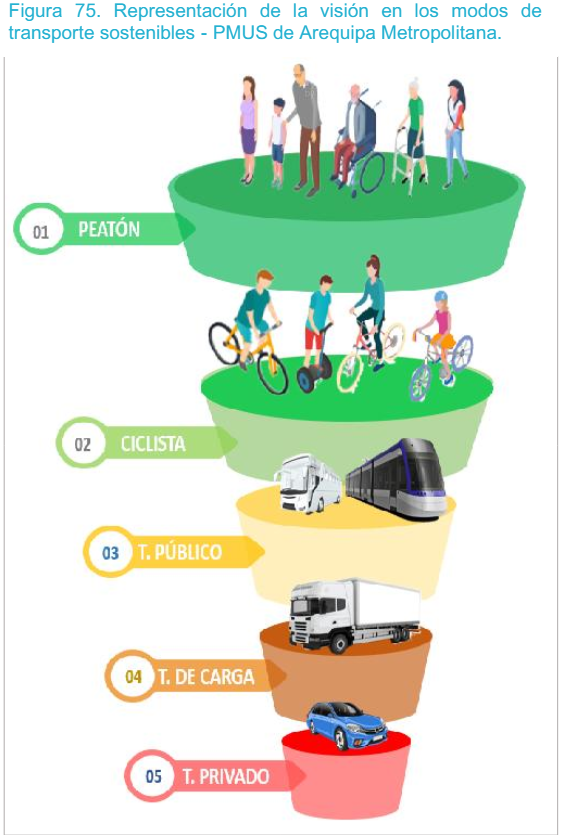Reimagining Mobility in Arequipa: Prioritizing Pedestrians and Cyclists

The recently adopted Sustainable Urban Mobility Plan of Arequipa strongly emphasises promoting active modes of transport, particularly walking and cycling. This focus is integral to achieving the plan's broader objectives of sustainability, improved public health, and enhanced urban liveability. The comprehensive approach outlined in the SUMP includes infrastructure development, policy frameworks, and community engagement strategies, all aimed at fostering a more active and healthier population.
The SUMP's vision is clear: "Metropolitan Arequipa has an urban mobility that prioritises pedestrians, bicycles, and public transport; it rationally uses private transport and intelligently manages a multimodal system in which negative impacts are reduced and environmental, social, and economic aspects are enhanced, seeking to improve the quality of life of citizens."
Overall Strategic Objectives
The strategic objectives of the Arequipa Metropolitan SUMP include:
- Promote greater participation in pedestrian and bicycle mobility.
- Promote a transformation of public transport towards a mass, integrated and multimodal system.
- Promote a more rational and efficient use of private transport.
- Promote a more sustainable management of urban freight transport and logistics.
- Promote intelligent traffic management for its regulation, monitoring and control.
- Reduce the environmental impacts of mobility and road accident rates.
- Promote improved universal accessibility, inclusion, equity and gender.
- Strengthen institutionality, governance and citizen culture.
- Implement a financial sustainability scheme for sustainable mobility.
- Promote a mobility model that supports sustainable urban development in the metropolitan area.

Pedestrian Mobility System
The pedestrian mobility system in Arequipa's SUMP is designed to ensure safe, accessible, and enjoyable walking experiences throughout the city. This system comprises several key components:
- Network of Accessible Intersections: This includes intersections equipped with safety measures and universal accessibility features, ensuring that individuals with mobility impairments can navigate the city with ease. The emphasis on such infrastructure reflects a commitment to inclusivity and safety, making walking a viable option for all residents
- Historic Centre Pedestrian Network: The plan prioritises pedestrian zones in the historic centre of Arequipa, limiting vehicle access to residents and emergency vehicles. This network interconnects public spaces, recreational areas, and cultural sites, enhancing the pedestrian experience and preserving the city's historical heritage
- General Sidewalk Network: Across the city, the SUMP aims to improve sidewalks, ensuring they are wide, well-maintained, and protected from vehicular traffic. This network facilitates safe and comfortable pedestrian movement, linking various urban centres and public transport services.
These components are guided by planning and design criteria that prioritise safety, accessibility, and the integration of pedestrian pathways with other modes of transport. By enhancing the pedestrian infrastructure, the SUMP not only promotes walking but also contributes to reducing vehicular congestion and pollution.
Bicycle Mobility System
Cycling is another cornerstone of Arequipa's SUMP, with a dedicated system to support and encourage its use. The bicycle mobility system includes:
- Metropolitan Bicycle Network: This consists of high-quality, segregated bike lanes designed to offer safe and efficient routes for cyclists. The goal is to make cycling a competitive alternative to motorised transport, reducing traffic and emissions while promoting physical activity.
- Basic Cyclist Facilities Network: To support cyclists, the SUMP includes the installation of bike parking and maintenance stations. These facilities are crucial for promoting cycling as a practical and convenient mode of transport and addressing issues like bike theft and maintenance concerns.
The bicycle mobility system is complemented by educational and promotional campaigns to raise awareness about cycling's benefits and encourage more people to adopt this mode of transport. The SUMP recognises that infrastructure alone is not enough; cultural and behavioural shifts are also necessary to make cycling a mainstream option.
Benefits of Active Mobility
The emphasis on active modes of transport in Arequipa's SUMP is part of a broader vision to create a sustainable urban mobility system. This vision aligns with national and international sustainability goals, addressing environmental concerns and promoting a healthier urban lifestyle:
- Health Benefits: Active mobility, such as walking and cycling, can reduce the risk of chronic diseases like obesity, diabetes, and heart conditions. The SUMP aims to improve urban environments to encourage these activities and promote a healthier lifestyle.
- Environmental Impact: The SUMP’s goal is to cut Arequipa’s carbon footprint by decreasing reliance on motor vehicles, thus reducing greenhouse gas emissions and air pollution. Encouraging walking and cycling helps combat climate change and improves air quality.
- Urban Development and Accessibility: The SUMP plans to develop cycling lanes and pedestrian paths to make travel safer and more efficient. This infrastructure improvement enhances the urban landscape, especially in densely populated and historical areas.
- Economic Advantages: Active mobility can save residents money on fuel and vehicle maintenance. Additionally, reduced traffic congestion leads to increased productivity. The SUMP includes financial strategies to support and sustain these mobility initiatives.
- Social Equity and Inclusion: Active mobility enhances pedestrian infrastructure and provides affordable transportation options for all socio-economic groups, improving accessibility for vulnerable populations such as the elderly and disabled.
Challenges and Future Directions
While the SUMP outlines a robust framework for promoting active mobility, there are challenges to its implementation. These include ensuring the safety of pedestrians and cyclists, securing funding for infrastructure projects, and overcoming cultural preferences for motorised transport. The SUMP addresses these challenges through a combination of regulatory measures, financial incentives, and public engagement initiatives. The plan also emphasises the importance of continuous monitoring and evaluation to adapt and improve strategies over time. This dynamic approach ensures that the SUMP remains responsive to changing urban dynamics and evolving transportation needs.
In conclusion, Arequipa's SUMP demonstrates a strong commitment to promoting active mobility through comprehensive planning and strategic investment in infrastructure. By prioritising walking and cycling, the city aims to create a more sustainable, healthy, and liveable urban environment. The successful implementation of these initiatives will require ongoing collaboration between government, community, and private sectors, but the potential benefits for the city's residents and the environment are substantial.
The SUMP has been developed by the EGIS-Rupprecht Consult consortium in collaboration with the Municipal Planning Institute of Arequipa (IMPLA) and the Provincial Municipality of Arequipa and supported by the French Development Agency (AFD).